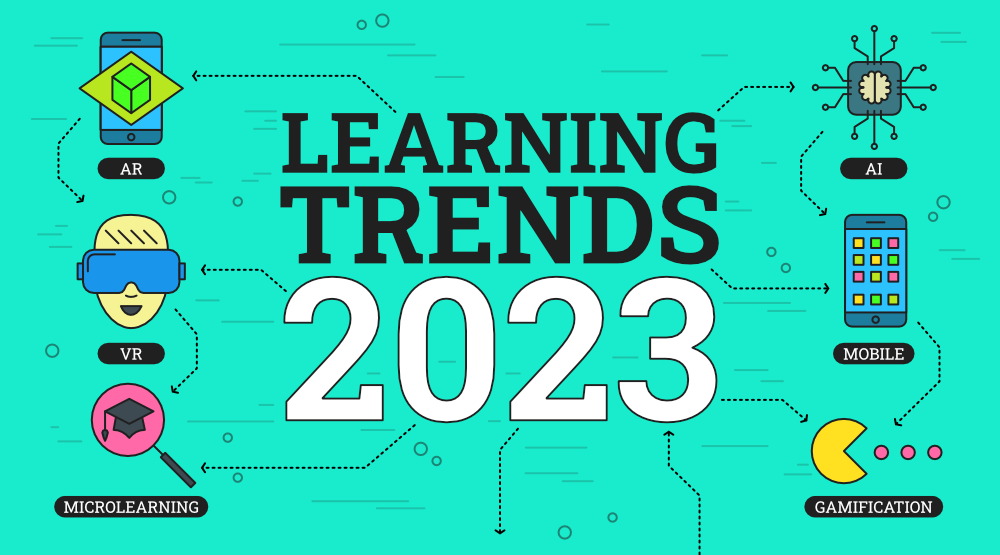Learning Trends 2023

The e-learning industry continues to evolve and grow and 2023 is already shaping up to be an exciting year, with developments in AI and the increasing demand for more personalised, convenient and flexible “anytime, anywhere” learning. This could be a good time for your Learning and Development team to look at some of the new and growing e-learning trends they may want to consider when finalising training plans for 2023.
Continued Growth of Mobile Learning
There is a good chance that you are reading this post on your smart phone. Your phone is always with you, always in your hand or within easy reach so it is understandable that many businesses are making use of this and have been implementing, or are now planning on implementing, mobile training for their employees.
Mobile learning has been one of the quickest evolving trends in recent years. It allows the learner to consume content wherever they want simply and easily on their smart phone. The content that is created for mobile learning must be responsive, it must have the ability to adapt to any screen size and it must be available to the user “on the go”. Mobile accessible content, by its very nature, engages more users and many employers are discovering that when employees can easily access training on their mobile devices it is being completed faster.
When considering mobile learning you may also want to consider what form the training will take, you might consider shorter content forms such as animations, videos or explainers, all of which are well suited to mobile learning.
Microlearning / Nanolearning
With the ever increasing demands on your digital attention and with shortening attention spans, Microlearning and Nanolearning is a trend that will continue to grow in 2023. It takes your existing or new course content and divides it into shorter, more effective segments allowing the learner to easily process and retain the information. Learners are presented with short videos, immersive learning interactions, simulations or infographics, each session being anywhere from 2-10 minutes in duration, thus avoiding an information overload. It is a very efficient way of learning, providing targeted, essential information to the learner in a very short space of time.
Micro and nanolearning are good partners to mobile learning as the content is provided in short snippets, easily formatted and produced for mobile use.
Integration of Virtual And Augmented Reality (VR/AR)
With VR and AR set to become a key part of training in 2023, training will no longer be a passive experience, as they’ll ensure a truly immersive experience for the learner. It will be hugely beneficial in certain industries, consider, for example, the risks which are usually involved when training new employees how to work a piece of machinery. AR & VR will provide the perfect platform for this kind of training, allowing the trainee to understand the mechanics, see and feel how to work the machinery without any of the risks normally involved in such a task. It can also be used to help deliver practical and effective training on real-world processes that may otherwise have been too costly, too dangerous, or too complex to deliver
Virtual and Augmented Reality technology is also becoming increasingly affordable and with VR use within businesses forecast to reach $31 billion in 2023 (Statista, 2022) it is not a trend that you would want to overlook when considering your 2023 training plan.
Increased use of Artificial Intelligence (AI)
AI powered e-learning is set to become even more popular in 2023. Artificial Intelligence provides the learner with a truly personalised, adaptive and fully immersive learning experience allowing them to adopt learning styles that suit them and provide support where needed.
With the release of its latest version in December, ChatGPT caused quite a stir with its incredibly fast and powerful outputs. ChatGPT is an AI-based generator of text content that responds to user’s inputs which can output a significant volume of content in seconds. Its immediate applications in the e-learning space include generating content such as learning objectives and content summaries, acting as a virtual teaching assistant by providing students with 1-1 instruction and answering questions in real time with detailed feedback, and as a language teacher to help students learn a new language by providing translations, exercises, or grammar checks. The company behind ChatGPT, OpenAI has significant investment from Microsoft and Google has just announced its own equivalent AI assistant, Bard so watch this space as AI is without doubt going to quickly evolve in 2023.
Gamification
In 2023, the use of Gamification in e-learning will continue to grow. Gamified learning helps to engage the learner in a fully immersive learning environment where various challenges allow them to become active participants, motivated to make decisions and learn in a fun and interactive environment. Some techniques used when developing gamified e-learning solutions are; sound effects, simulations, point-scoring and progress bars. Applying gaming mechanics to non-gaming environments can also make difficult tasks more palatable and enjoyable.
Outsourcing e-learning Content Development
A key consideration for all businesses when developing a training course is considering how you are going to make best use of the learning material you have. Creating efficient, practical and well planned eLearning content is vital and this is where you might want to consider outsourcing your training content to a qualified e-learning development company. This is the best way to ensure that the content created will be curated to your specific requirements. You will be working with a team of experts who have in-depth experience and knowledge and are up to date with all the latest trends and technologies ensuring that the finished product will be meaningful and affect real ROI for your business.
Contact
We hope you found this post helpful. If you would like more information please contact Esus E-learning at info@esus.ie.
